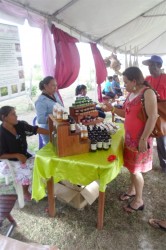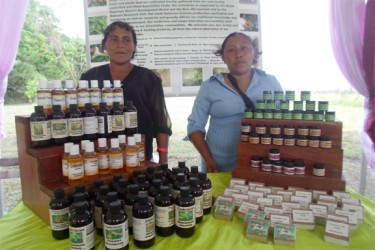If Veronica Farias has her way each person in the indigenous Makushi villages perched on the edges of the north Rupununi savannah would be using natural oils, locally-made soap and medicine from trees.
For three days a month, Farias and her colleague Rita Francis gather their oils, soaps and medicines and with hardly any protection from the harsh Rupununi sun, traverse up and down the hills of Annai, Rupertee, Kwata-mang, Aranaputa, and Wowetta telling, selling, demonstrating and dispensing their products to the local residents. “Sometimes we walk, sometimes we go with bicycles,” Farias said.
In this region of Guyana where the savannah meets the Pakaraima Mountains that mark the beginning of the forest, it can be miles to the nearest health centre and even further to find a doctor at Lethem close to the border with Brazil.

Enter Medicine from Trees, a group comprising women from different Amerindian communities of the north Rupununi who produce a variety of traditional medicines, tinctures, soaps and healing salves from botanicals and herbs. The natural remedies are made from trees and plants that are cultivated locally and gathered from the surrounding areas. The women produce, package and market their products as well as conduct research. Medicine from Trees is based at the Bina Hill Institute and is supported by the North Rupununi District Deve-lopment Board (NRDDB) and the Makushi Research Unit (MRU) of Bina Hill.
These days the group comprises Farias and Francis. Farias joined the group in 2006 but even before then, research on the botanicals and herbs of the north Rupununi was done and a book complied by others. In the early days, Farias said, there were only a few products and based on feedback, the range of products was increased.
There are crabwood oil and crabwood oil products such as creams for itches, rashes, cuts and sores, bloodwood bark cream for ringworm, tinctures for rheumatism and arthritis, for pain caused by hypertension, kiambe tincture for pain caused by cervical cancer and haemorrhage, tinctures for fever and pain in the backbone, neck and joints. There are also soaps such as coconut oil soap good as a moisturizer and crabwood oil for use as insect repellent among others.
“Every little thing sells every day,” Farias said, adding that people have become fans of the products. Initially, she said, people were not certain how to use the products since they had no proof that it worked. “We focused on the ones that were working and stopped making the ones that were not working,” she recalled. They even did surveys and their customers became happier with the products.
The medicines and soaps are mostly sold in the villages but the group has had the opportunity to attend the GuyExpo trade fair and fairs in Region Nine. The market is “50/50,” Farias said, mainly because their main market is the surrounding communities. However, persons from Georgetown who have used their products have contacted them saying that the remedies work and requested more, she said.
Farias said that she was initially not interested in traditional medicines but she heard vacancies being advertised through the local community radio and applied and her interest rose when she saw the work being done. “I know from small about the plants but I din had this idea to make it into medicine,” she recounted. “I used to do it just to make for my own use,” she added. “I keep falling in love with the nature, go out into the fields, look for plants, look for seeds.”
As for Francis, she was the MRU worker at her village, Kwatamang. “I had a child, I left the work and this girl she wrote me a letter and call me and since then I start work with them,” Francis recalled, smiling shyly. She joined the group in 2009.
She said that she never made traditional medicine before but learnt from the older folks. She remains in the group because of her interest in keeping their culture alive, she said.

The women work every first week of the month for the full seven days and then spend three days doing community work where they sensitize people about their products and do some marketing. They also visit the homes of patients, travelling miles to cover at least five villages, to ensure that they are taking the medication as prescribed. “People from gold bush come here and say this thing prevent bush yaws,” said Farias indicating the crabwood oil. She said that the remedies would work faster than the ones purchased in stores.
The income earned goes back to the NRDDB from where they are paid and while what she earns is not enough to support her family, it is more than money that keeps her going, Farias said. “It’s just my commitment keeps me here,” she said. “It’s not because I am making money.”
Farias said she was fearful that there would be less interest from others in doing what she does and she wants to keep traditional medicine alive. She noted that two other women had joined the group but left and the woman who taught them, Cecilia Geoffreys, has retired.
The group had received some support in packaging – which was the biggest expense – from a group in the United Kingdom as well as some funding from the Inter-American Development Bank (IDB) via Bina Hill but that support is over from this year, Farias said.
She said at the start, they were operating at a loss but are now passing the targets set. “One day we will become [financially] independent,” she said hopefully. In the future, she would like the group to expand and employ more women, Farias said. She was happy that many people of the area want and use their products, which sell at a reasonable cost. Both women said that they are happy continuing their traditions.








